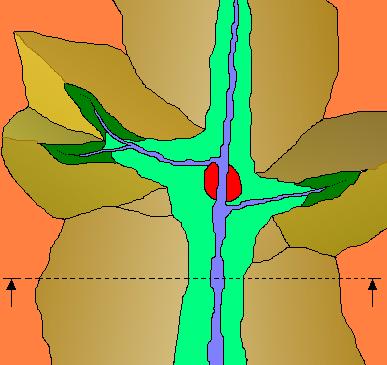 Annahme: ein fiktives Tal,
Annahme: ein fiktives Tal,semiaride Umgebung
Vergleich und Alternativvorschläge zu Umstrittenen Großstaudämmen
Prämissen: 1. Großstaudämme sind unnötig, da
Fallhöhe mal Volumenstrom gleich
Energiepotenzial,
nicht mit dem Stauvolumen zusammenhängen.
2.
Nicht die Größe koreliiert mit der Effizienz, sondern der Fortschritt
und
die
Größe wuchsen gleichzeitig.
 Annahme: ein fiktives Tal,
Annahme: ein fiktives Tal,
semiaride Umgebung
Legende Farbe:
blau= Fluss, rot= Stadt,
hellgrün= Ackerbau,
dunkelgrün= Wald
ocker= Hang(Weide)
orange= Hochebene
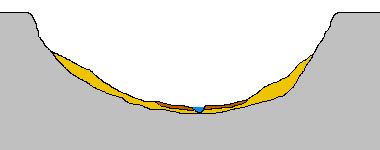
Talprofil
Legende Farbe:
grau= Fels, ocker= Geröll
braun= Ackerboden
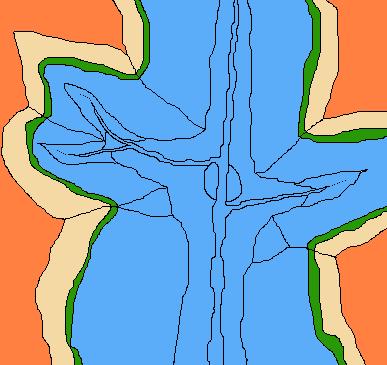
Planung vor 30 Jahren
Geflutetes Tal des Großstaudamms
Vertreibung oder Entschädigung der
Bevölkerung (Preis für Ackerland?),
28200 Personen, Kosten der Neuansiedlung,
Jahrelanger Wasserentzug für Auffüllung,
Vernichtung von Infrastruktur, Anbaufläche,
Natur, Heimat, Altertümern....
Riesige Verdunstungsoberfläche, dem
Wind ausgesetzt, Zerteilung der Verkehrswege
für 2,9mio Menschen,
toter Uferstreifen durch Wasserspiegel- fluktuation...
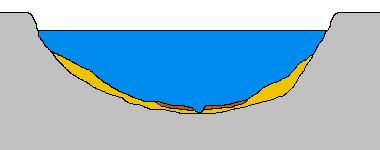
Talprofil
Steilhänge ohne Möglichkeit für Landwirtschaft,
schlechte Wasser- qualität bei versenkter Biomasse.
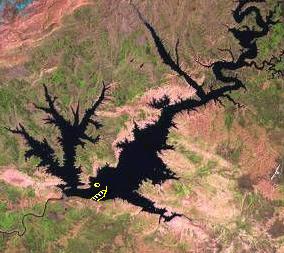
Bild Beispiel= Attatürk "Monster"-
Staudamm aus dem
GAP (Southeastern Anatolian Projekt)
von 1978 !
Heute: Baubeginn verhindern:
GAP-Ilisu Staudamm Projekt:
Inhalt:10,4 Milliarden m³
Fläche: 313 km³
Installiert: 1200 MW
Leistung: 3800GWh/a
Quelle:CEPMLP-Dundee
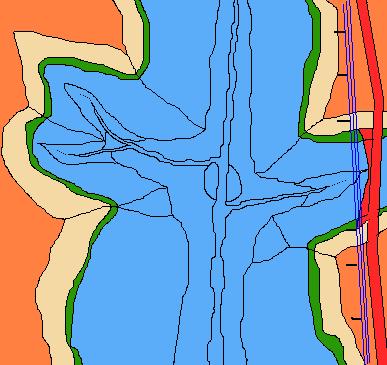
Teure neue Straßenprojekte oder
Mmarginalisierung der abgeschnittenen
Gegenden,
Friedens und Sicherheitsbedrohung
durch die gewaltigen Wassermassen,
Ständige Lieferbereitschaft um
die Kredite der Investoren zu bedienen
Weitere Folgen werden in der Forschung
und Literatur über den Assuanstaudamm
beschrieben.
Bücher:
Staudämme
ISBN 3-88977-202-1
Silenced Rivers
ISBN 1-85649-902-2
Alternativplan für fiktives Tal

Alte Planung:
bequeme Absperrung an Engstellen,
Prestigeobjekt
 Neu:
Neu:
fast gleiches Energiepotential,
Verdunstungsersparnis für
Landwirtschaft nutzbar,
kleine und moderne Turbinen im
Land herstellbar
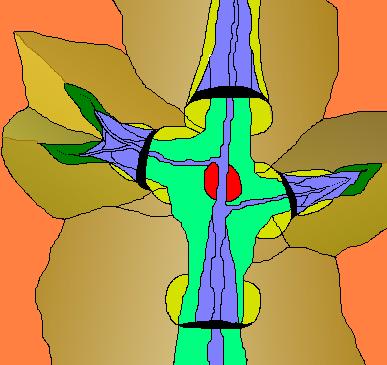
Gestaffelte Staustufen:
Nachteile: viele Baustellen, weniger Prestige,
weniger politische Macht,
weniger gesicherte Kapitalrendite.
Vorteile: Bevölkerung/Heimat bleibt,
Ackerflächen bleiben, Natur bleibt,
Verkehrswege und Infrastruktur
gehen nicht verloren,
Demokratieaufbau durch Kooperation
derAnrainer nach Allmende Grundsätzen.
Legende Farbe: Gelb=Neugewonnene Äcker
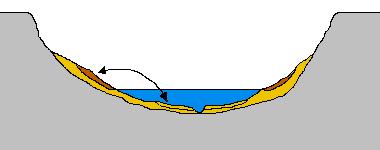
Abtransport der Kulturböden auf die neuen Uferstreifen.
G.g.F Reisanbau bei Wasserspiegel-Absenkung.
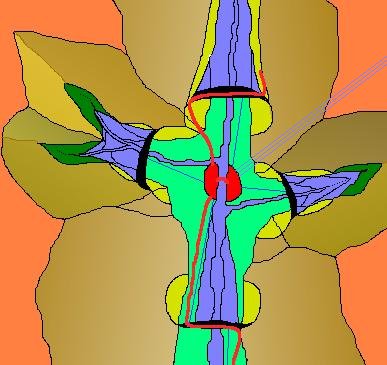
Legende Farbe:
Rote Linie= Neue Straße
Blaue Linie= Stromleitungen
Kleinstaudämme haben auch Brückenfunktion.
Umspannwerk für Stromexport im Knotenpunkt.
Turbinen
die im Jahre 1967 gebaut wurden
haben heute, bei gleichen Verhältnissen ca.
50% mehr Leistung.
Quelle:
Voith
Turbo-Institut
Danzig
VA
TECH HYDRO
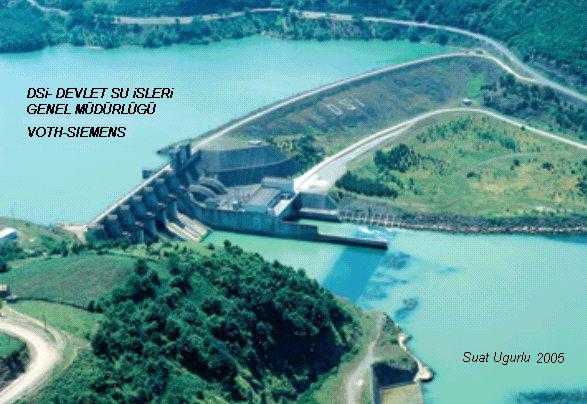
Beispiel
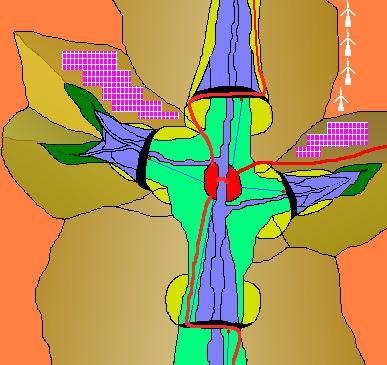
Ausblick
Die Sonnenenergie in diesen Ländern
ermöglicht eine teilweise Erhöhung der
Stromproduktion in den Abendstunden
08.01.2007 Ivo Krieg
3. Fassung
****** English Version ******
Comparison and alternative suggestions to controversial giant dams
Premises: 1. Large dams are unnecessary, because
height
of drop multiplicated with volume feed, equals
energy
potential and are not related with the reservoir volume..
2.
Not the size correlates with the efficiency,
but
the know-how and the size grew at the same time.
 Assumption:
Assumption:
a typical valley,
semiarid environment
Colour key:
blue = river, red = city, ,
pale green = agriculture,
dark green= forest
ochre= slope pasture
orange= plateau

Cross-section of valley
Colour key:
grey = rock, ochre = rubble
brown = topsoi
 Planning from 30 years
Planning from 30 years
ago
Flooded valley of the large dam
Expulsion or compensation of the
population (price of arable land?),
28200 persons in this case.
Costs of the new settlement.
Many years of water theft for reservoir
replenishment, drowning of infrastructure,
cultivated soil, nature, native identity, antiquities....
Gigantic vaporisation surface,
exposed to the wind,
interuption of the traffic routes for 2.9 Mil. people,
dead bank stripes by water level fluctuation...

Cross-section of submersed valley
Steep slopes without possibility for agriculture,
bad water quality through submersed biomass.

Satilite picture
Exemplary "monster" dam: Attatürk
from the
GAP (South-eastern Anatolian Projectt) year 1978 !
Today: prevent to build:
GAP-Ilisu dam project::
Capasity:10,4 billion m³
Area: 313 km²
Installiert: 1200 MW
Power: 3800GWh/a
Reference:CEPMLP-Dundee

Expensive new street projects or
marginalization of the cut-off areas,
Colour key:
red line = new motorway
blue line = cross-country line
Peace and security menace
by the immense water masses
to the valley below,
Constant readiness of power delivery
to serve the loans of the investors
Other results are described in research
and literature, e.g., about the Aswan dam..
Books:
Staudämme
ISBN 3-88977-202-1
Silenced Rivers
ISBN 1-85649-902-2
Alternative plan for fictive valley

Old planning:
comfortable block at narrow ravine,
prestige objectt
Comparison of waterhad
 New:
New:
Almost the same energy potential,
Vaporisation savings, for agriculture,
small and modern turbines,
producible inside the land.

Small dam cascade
Disadvantages:
many building sites,
less prestige, less political power,
less secure capital yield
Advantages:
Population and home relationship remains,
agriculture topsoil remains,
nature diversity remains, traffic routes
and infrastructures do not get lost,
democracy build-up by cooperation of the
neighbours according to the concept of the common.
Colour key:
Yellow= newly cultivated

Exchange of slope gravel and organic top-soil.
Cultivation of rice on new bank
stripes with water level fluctuation possible.

Colour key:
Red line = new road
Blue line = overhead power line
Small dams also have a bridge function.
Transformer station for power export
in the centre.
Turbines which were built in 1967
in comparison have today approx.
50% more capacity, in the same situations.
Reference:
Voith
Turbo-Institut
Danzig
VA
TECH HYDRO

Example

Further chances
The solar energy in these lands
allow a partial rise of the power production
in the evening hours due to
abundant energy during daytime
08.01.2007 Ivo Krieg
3. version